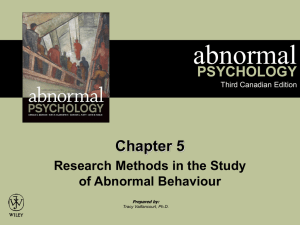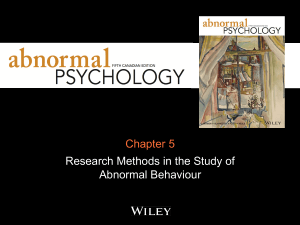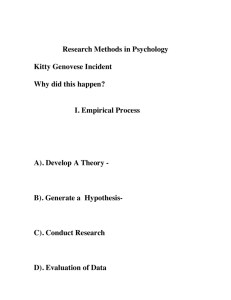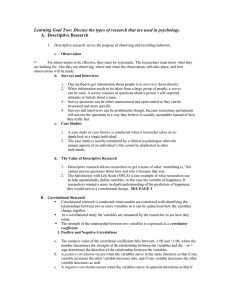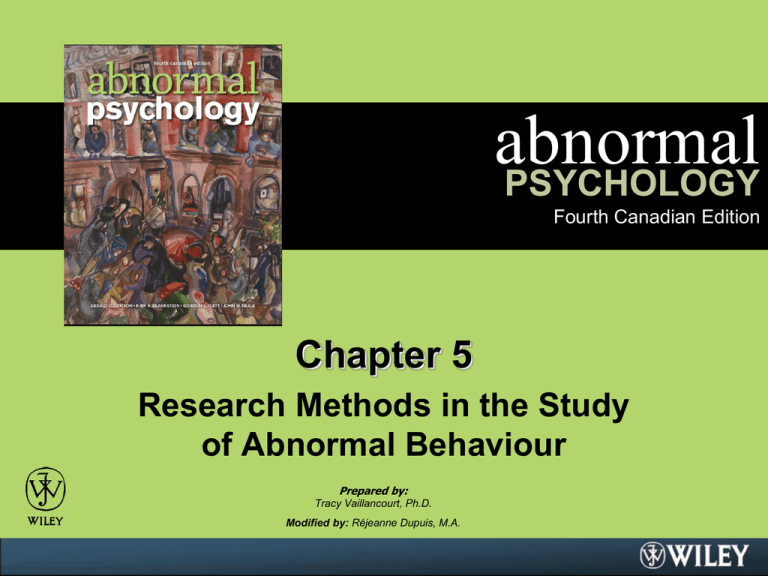
abnormal
PSYCHOLOGY
Fourth Canadian Edition
Chapter 5
Research Methods in the Study
of Abnormal Behaviour
Prepared by:
Tracy Vaillancourt, Ph.D.
Modified by: Réjeanne Dupuis, M.A.
Chapter Outline
A. Science and Scientific Method
I.
II.
Testability and Replicability
The Role of Theory
B. Research Methods
I.
II.
III.
IV.
V.
VI.
VII.
The Case Study
Epidemiological Research
The Correlational Method
The Experiment
Single-Subject Experimental Research
Mixed Designs
Meta-analysis
A. Science and Scientific Methods
• Science: The pursuit of systematized knowledge
through observation
I. Testability and Replicability
a.
b.
A hypothesis must be amenable to systematic
testing that could show it to be false
Hypothesis: Expectations about what should occur if
a theory is true
II. The Role of Theory
a.
b.
Primary goal of science is to advance theories
Theory: A set of propositions meant to explain a
class of phenomena
B. Research Methods
I.
Case Study
•
The detailed study of one individual, based on a paradigm
•
Providing detailed descriptions
− Collecting historical and biographical information
− Often includes details of therapy sessions
− Several case studies can be compared and analyzed for
common elements through a specific method
•
The case study as evidence
− Particularly useful to negate a universal theory or law
− Not useful to rule out alternative hypotheses
•
Generating hypothesis
− Exposure to a large number of cases may allow the clinician to
notice similarities of circumstances and outcomes
B. Research Methods
II. Epidemiological Research
• Epidemiology: Study of frequency and distribution of a
disorder in a population
– Data are gathered about the rates of a disorder and its possible
correlates in a large sample or population
– Provides a general picture of a disorder
• Focuses on determining 3 features of a disorder:
1. Prevalence: Proportion of a population that has the disorder at a
given point or period of time
2. Incidence: # of new cases of the disorder that occur in some
period, usually a year
3. Risk factors: Conditions or variables that, if present, increases
the likelihood of developing the disorder
B. Research Methods (cont.)
III. Correlational Method
• Is there a relationship between or
among 2 or more variables?
Measuring Correlation
• Correlation coefficient (r)
– May take any value between
+1.00 and -1.00
– Measures magnitude and
direction of relationship
Statistical Significance
• Likelihood results of an
investigation are due to chance
Applications to Psychopathology
B. Research Methods (cont.)
III. Correlational Method cont.
• Problems of Causality
• Critical drawback of correlational research
– Does not allow determination of cause-effect relationships
– Correlation between two variables tells us only that they are
related or tend to co-vary with each
• Directionality problem
– How can we tell which is the cause and which is the effect?
– Correlation does not imply causation
– Prospective, longitudinal design helps resolve the directionality
issue
– High-risk method: individuals with a predisposition are studied
• Third-variable problem
B. Research Methods (cont.)
IV. Experimental Design
• Generally considered most powerful tool for determining
causal relationships between events
– Involves (1) random assignment of participants to different
conditions (2) manipulation of IV and measurement of DV
• Basic Features of Experimental Design
1. Researcher typically begins with an experimental hypothesis
2. Investigator chooses an independent variable (IV) that can be
manipulated
3. Participants are assigned to the two conditions by random
assignment
4. Researcher arranges for the measurement of a dependent
variable (DV)
5. Produces an experimental effect
B. Research Methods (cont.)
IV. Experimental Design cont.
• Internal validity
– Extent to which effect can be confidently attributed to
manipulation of IV; Inclusion of at least one control group
• Confounders
• Placebo Effect
– Placebo control group; Double-blind procedures
• External validity
• Can the results be generalized beyond immediate study?
• Analogue experiments
– The use of a related phenomenon (an analogue) in the lab
• Randomized Controlled Trials (RTC)
B. Research Methods (cont.)
V. Single-Subject Experimental Designs
• Participants are studied one at a time and experience a
manipulated variable
– Reversal design or ABAB design
Measurement of a specific behaviour at different times:
(1) During an initial time period, the baseline (A)
(2) During a period when treatment is introduced (B)
(3) During a reinstatement of the condition that prevailed in the
baseline period (A)
(4) During the re-introduction of the experimental manipulation
(B)
B. Research Methods (cont.)
VI. Mixed Designs
• The combination of experimental and correlational
designs
• Classificatory or correlational variables (e.g., having
PTSD or not) are not manipulated nor created by the
researcher
• Experiments demand the manipulation of a variable
(e.g., 3 types of treatment for major depression)
B. Research Methods (cont.)
VII. Meta-Analysis
• The review of several studies in order to determine the
effects of treatment, using a statistic called effect size
• Meta-analysis can hardly provide definite answers b/c:
1. It is a complicated process that requires decisions at each of
numerous phases or steps
2. Results of a meta-analysis are difficult to interpret
• Despite difficulties and shortcomings, meta-analyses
have been useful
Summary
Copyright
Copyright © 2011 John Wiley & Sons Canada, Ltd. All rights
reserved. Reproduction or translation of this work beyond that
permitted by Access Copyright (The Canadian Copyright Licensing
Agency) is unlawful. Requests for further information should be
addressed to the Permissions Department, John Wiley & Sons
Canada, Ltd. The purchaser may make back-up copies for his or her
own use only and not for distribution or resale. The author and the
publisher assume no responsibility for errors, omissions, or damages
caused by the use of these programs or from the use of the
information contained herein.

